Happy All-Hallow’s Month! In anticipation of Halloween — which, let’s face it, we’ve been anticipating since last Halloween — Daily Grindhouse will again be offering daily celebrations of horror movies here on our site. This October’s theme is horror sequels — the good, the bad, the really bad, and the unfairly unappreciated. We’re calling it SCREAMQUELS!
And if you like this feature, please check us out on Patreon for unique reads and deep dives! Just $3 a month gets you everything! All treats, no tricks.
[Spoilers for THE STRANGERS (2008) and THE STRANGERS: PREY AT NIGHT (2018) follow]
At some point it became a bit of shorthand to talk about Michael Myers in HALLOWEEN films as a “shark”—an unfeeling creature spurred on by impulse that destroys what’s in its path. Even when given a sort of motive like finding his sister, or his niece, or doing the bidding of an ancient Celtic cult, Myers is emotionless and unrelenting as he’s constantly in motion. Loomis and others talk about the evil that lurks behind his eyes like Quint in JAWS talking about the sharks that came for his fellow crewmen after the Indianapolis sank. What differentiates the masked killers of THE STRANGERS and its sequel from Haddonfield’s most famous son (and indeed most costumed slashers) is that, while they also don’t display emotions, they prey on the psychological vulnerabilities of their victims in a way that can only really be described as “a game”. So, to continue the aquatic analogy, the antagonists in 2018’s THE STRANGERS: PREY AT NIGHT aren’t sharks; they’re more like a pod of killer whales.
Mike (Martin Henderson) and Cindy (Christina Hendricks) are trying their best as parents but feel they have been left with no alternative but to enroll their daughter Kinsey (Bailee Madison) into boarding school. Hopefully there she will stop ditching class and getting into trouble. In an attempt to put a shine on the tense situation, the family, including Kinsey’s brother Luke (Lewis Pullman), set out on a road trip to the school. They are going to briefly stay over at a secluded trailer park in Ohio run by Cindy’s aunt and uncle. The park is deserted following Labor Day, so it is startling when the family is greeted by a knock on the door and a girl asking if “Tamara” is there. Soon after, the family discovers what happened to Cindy’s aunt and uncle as three masked killers emerge and proceed to hunt down the four embattled family members who are cut off from the rest of the world.

It’s common for sequels to incorporate some form of escalation from the previous entry in a series. One alien? How about a planet full of them! Taking out terrorists in a building? What about terrorists across all of New York City! The stakes must be higher, as must the bodycount, because there is a need to show this installment is the craziest yet. It would be easy to misinterpret director Johannes Roberts’ THE STRANGERS: PREY AT NIGHT as such an expansion on the original STRANGERS movie (released ten years previously): it’s not just confined to one cabin, the body count is technically higher, it involves parents and children and not just an awkwardly stilted romantic couple, there’s flames, and neon, and more than just a couple of music cues. Roberts, working with writers Bryan Bertino (who wrote and directed the first STRANGERS) and Ben Katai, clearly is just going for bigger is better, right? I don’t think that’s the case.
2008’s THE STRANGERS is so effective because so much of it is grounded—whether it’s the way actors Liv Tyler and Scott Speedman realistically portray the aftermath of a couple’s argument (and essentially a break-up), or the very strict and specified sense of geography in the house and area around where everything is happening, or even protagonists and antagonists both making small mistakes that almost unravel everything (and kill poor Glenn Howerton). The lighting is naturalistic with an effective use of real shadows and bulbs to remove the sense of polish (even though that cabin is pretty damn posh). The killers aren’t ever really revealed, and their motive is anarchic at best: choosing to terrorize and assault and kill these people just because they were home. All of that resonated with audiences awash in a love affair with home invasion horror. Ask around and those would probably be the highlight responses for what they loved about Bertino’s film.
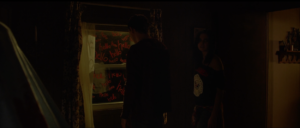
But what Roberts, Bertino, and Katai suggest with PREY AT NIGHT is that the vulnerability to this nihilistic madness doesn’t only exist within the walls of your house. To put it in Rat Pack terms: it’s the Strangers’ world and you’re just living in it. The hold-overs from the 2008 movie are minimal (three killers, in the same masks, with the same ritual of asking for “Tamara”), but the intensity, shock, fear, and danger is similar and at just as high a level.
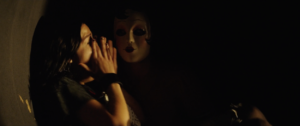
The essence of what made STRANGERS work, then, wasn’t the home invasion—our leads aren’t at home. Hell, they aren’t even inside a whole bunch of the time. The essence wasn’t in the visual aesthetics, either; while there are some similar shots where a killer emerges from (or slinks back into) the shadows, most of the subdued set and muted golden/brown color palette is tossed out for darkness, tacky neon lighting, blinding headlights with lens flares, and much more movement as required by the increase of space. In fact, if you were to show someone that just saw STRANGERS (2008) the incredible pool scene from PREY AT NIGHT, except for the mute masked killers…they may not see any connection at all.
And yet these changes in style and setting don’t keep THE STRANGERS: PREY AT NIGHT from feeling like a continuation of its predecessor. That comes into the fact that, even with all the heightened elements (the soundtrack, the bigger set pieces, the slightly larger number of corpses), PREY AT NIGHT retains a feeling of regular people finding themselves at the mercy of people with no morality or rationality. The killers have purpose and goals, but no motive. If the central character from Camus’ The Stranger (waitaminute) put on a sack cloth mask with a crude smiley face, then this is what one gets. Which is what always terrifies people the most—not knowing why something bad happened. Because that is how God operates.

It’s usually couched in a positive spin (“works in mysterious ways”), but there isn’t much rhyme or reason for horrible events that befall non-horrible people. PREY AT NIGHT feints at the idea that the family is troubled and, like the crumbling couple from the 2008 film, that distance invites the chaos. But no–it’s shown that they are in an awkward and unhappy moment, but generally they’re fine with each other and doing their best. The reason people crave knowing about what motivates killers—what was the inciting incident that made them murderers?—is to figure out how to avoid that in their life or to make it less likely to occur to others.
If it’s genetics, well, that sucks, but we know it’s just funky biology left over from our savage past. If it’s upbringing, then we understand the pain the slashers felt and, while not excusing it, we can empathize and be sure to teach others not to raise their children in that manner. Was it a bad day at work? Drugs? Religion? Money? Some other known temptation that lures people to act inhumanly towards other people? When asked why this is happening, the only answer Dollface (Emma Bellomy) gives through a mouth full of blood is “why not?”
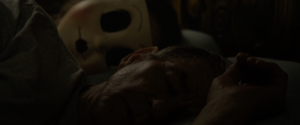
And this brings us back to the worst clown since Pennywise, Michael Myers and John Carpenter’s HALLOWEEN. Myers is an unnatural beast who is dismissed as the boogeyman with some evidence to suggest that may not be completely wrong. How else did he learn to drive? Survive getting shot, stabbed in the neck and in the eye, fall out a window, and more? He hauled a tombstone out of the earth and up a flight of stairs. This is superhuman activity; meanwhile the trained professional (and Myers expert) Loomis is on hand to constantly insist that he is pure evil. His motive isn’t clear, but his actions have a purpose, and he carries them out in ways that seem beyond the ken of normal people (even those controlled by an ancient Celtic cult). The Strangers are regular people. They aren’t super strong, they perform no incredible feats. There is one slasher psych-out “not really dead” bit towards the end, but even that doesn’t feel completely divorced from reality. They are not Evil Incarnate set loose upon an unsuspecting populace one hallowed evening. They’re the kids in America, who decided—possibly on a whim—to act out their destructive fantasies and see the various ways they can toy with, hurt, and kill people, while never expressing anything approaching glee, anger, sadness, or the like.

And Carpenter is very much on Roberts and the other filmmakers’ minds. The main theme from the film’s score is clearly inspired by the horror master’s musical work on THE FOG. There are shots with a flaming car and bright halogen lights that cannot be anything else but a nod to CHRISTINE. Like most of Carpenter’s horror work, the characters aren’t wunderkinds but average people trying to get by with their own set of problems. Much like the multi-hyphenate Carpenter, Roberts also wants music to play a large role in his film, but unlike Carpenter he uses ‘80s pop music (though Adrian Johnston’s score does expertly add mounting tension and atmospheric horror like in Morricone’s THE THING and PRINCE OF DARKNESS).
Jim Steinman-penned ditties like “Total Eclipse Of The Heart” and “Making Love Out Of Nothing At All” along with songs from Kim Wilde and False Moves are used in diegetic fashion—playing on the radio of cars and in areas of the park, indifferent to the carnage and terror unfolding on the ground. The irony in using these songs is less that they are love songs and pop hits that people belt out on road trips and in karaoke rooms across the world, more that they are full of operatic emotion. These are bombastic tunes of epic proportions of broken hearts and yearning desires and they are playing behind villains who have no facial expressions except what was painted on the mask. The violence is certainly on par with those intense aural aspects of PREY AT NIGHT, but the sounds of someone plaintively singing a sad love song (written by someone else, mind you) can’t actually reach the depths of despair and depression evoked by the noises of victims crying for mercy, wailing out of pain, or howling over the death of a loved one in “real life”. Those Steinman songs, which were always meant to evoke an all-consuming feeling around hot rods and rivalries and romances that beat loudly in the heart of the mythic American teen, are one type of emotion and design; the pain of Kinsey and her family is another; and then there is the playful apathy of the Strangers who have made the world their murderous playground and yet seem to derive no joy out of it. Even when rocking their favorite FM hit.
The music was so important that each of the three killers has their own Spotify playlist with songs from the film and of similar ilk. It’s this weird, brilliant, metatextual move that combines the bathetic world of pop acts with the numb inner lives of people who engage in brutally torturing the innocent through bizarre games, yet don’t exactly take any real pleasure or purpose from it. This one, for example, is for the Man in the Mask.
THE STRANGERS: PREY AT NIGHT is an incredible sequel that does escalate from the previous STRANGERS movie, but only to reveal that no rules apply when no code or morality is at play. It quietly erases further signs of security where even the open world is seemingly just as secluded and confining as a remote cabin in the woods. In addition to extending the work from the first one, Roberts puts a ton of references into PREY AT NIGHT that include John Carpenter, Tobe Hooper, Jim Steinman, Steven Spielberg, and many more. This creates an air of familiarity—the audience knows that movie reference or they love this song—only to have it juxtaposed with startling moments where these killers appear out of nowhere, act however playfully or menacingly they wish, which ferments an unease that the world we know is a light veil over the world that belongs to The Strangers.
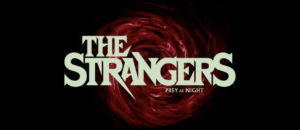
In fact, something I think about often is that there’s no reason to believe these are the same three killers from the 2008 film. Or even that it’s only three killers at the park attacking Kinsey and her clan. We (kind of) see the faces of two of them behind the mask, and they die, but why couldn’t there have been more? Either copycats or a larger group of nihilistic spree killers with a flair for the dramatic but no real emotional investment. That’s how Johannes Roberts and his team make this a worthy follow-up: opening up the world but not shining more light on it. The shadows stretch far in THE STRANGERS: PREY AT NIGHT and that’s where the monsters lurk not just to kill but torment like a group of killer whales acting together to assert their dominance over the lives of those in their path.
THE STRANGERS (2008) is currently streaming on Netlfix US and THE STRANGERS: PREY AT NIGHT (2018) is also currently streaming on Netflix US.
Tags: Adrian Johnston, Air Supply, Aviron Pictures, Bailee Madison, Ben Ketai, Bonnie Tyler, Bryan Bertino, Carla Shivener, Christina Hendricks, Damien Maffei, Emma Bellomy, Freddy Waff, Home Invasion, Jim Steinman, Johannes Roberts, john carpenter, Kay Wolfley, Ken Strunk, Kim Wilde, Lea Enslin, Lewis Pullman, Marilyn Martin, Martin Henderson, Mary Louise Casanta, Masked, neon, Paul Luther Jackson, Preston Sadleir, Ryan Samul, Screamquels, Sequels, The Strangers, The Strangers (2008), Trailer Park

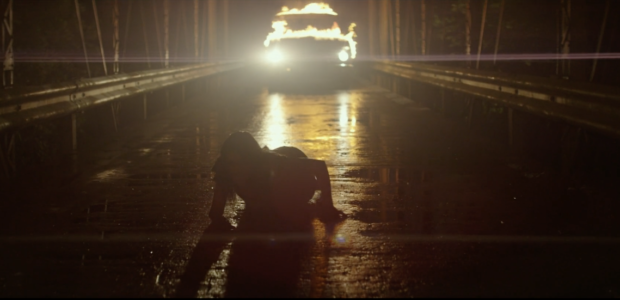

No Comments